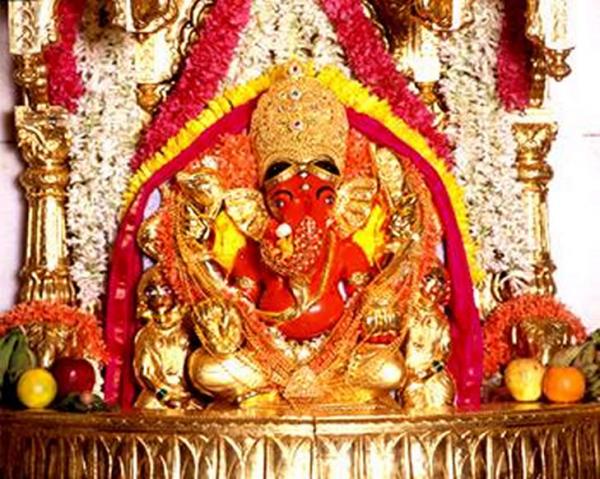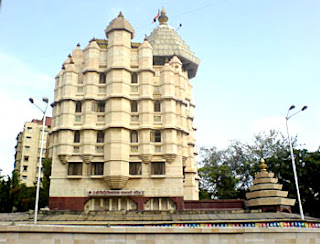The temple was first consecrated on Thursday 19'th November 1801. The idol made of black stone was placed in a small structure; the existing temple was rebuilt on the site of a 200-year old temple. The narrow lane outside the temple is the 'Phool galli' lined with innumerable stalls selling tulsi flower garlands, coconuts, an array of sweets including the pear shaped favourite yellow sweet of Lord Ganesha, the 'modak', and a range of religious paraphernalia.
SiddhiVinayak temple at Prabhadevi in Mumbai. This Vinayak temple in Mumbai is one of the oldest temples of the city. On Tuesdays, the serpentine queue of worshippers is almost over 2kms long. There are a lot of pujas performed in the temple, as the lord here is believed to remove obstacles in every ones way. Sankata Chathurhi, and Ganesh Chathurthi are celebrated with a lot of pomp here. An estimated 1.5-to 2-lakh people visit this temple every Tuesday.
The sanctum here houses a small mandapam enshrining Siddhi Vinayak. The inner roof of the sanctum is plated with gold, and the wooden doors to the sanctum are carved with images of Ashta Vinayak.
The idol of Ganpati has four arms therefore He is also called Chaturbhuj. A lotus is held in the upper right hand and a small axe in the upper left, holy beads are held in the lower right and a bowl full of Modaks (a delicacy which is a perennial favorite with Sri Siddhivinayak) in the lower left. Flanking the deity on both sides are Riddhi and Siddhi, goddesses signifying sanctity, fulfilment, prosperity and riches. On the forehead of the deity there is an eye, which resembles the third eye of Lord Shiva. Most icons of Ganapati depict the elephant faced God with his trunk curled towards his left. Siddhi Vinayak in Mumbai, Siddhi Vinayak at Siddhatek in Maharashtra as well as Karpaka Vinayakar at Pillayarpatti in Tamilnadu are depicted with a trunk pointing to the right (Valampuri).
The temple as it stands now was re-constructed five years ago after deliberations with experts on Hindu religion and customs, so as to maintain the sanctity of the idol as per the Hindu Shastras. The temple has a Kalash, which is a pointed dome of 12 feet high Gabhara (sanctum sanctorum) weighing 1500Kgs and plated in gold. The Kalash, which adorned the earlier temple was lowered with proper rituals and is kept as an exhibit within the temple premises. The devotees earn the satisfaction of seeking the blessing of The Lord by taking a devoted look at the Kalash. The idol has not been touched in the process of rebuilding the temple, so as to ensure that there is no human transgression in the area from the point at which the idol is situated. The Gabhara of the new temple structure has been designed with an aim to attain maximum convenience and comfort for the devotees. It is a spacious enclosure with 3 main doors of about 13 feet height. This facilitates the 'Darshan' of Sri Siddhivinayak from either the area surrounding the Gabhara or the stage (Sabha Mandap) constructed to conduct pujas and festivities.
The area surrounding the Gabhara has been designed as a sitting area and the stage adjoining the same is utilised as a platform for common Darshan sought by the devotees who are unable to spend hours in serpentine queues to go inside the Gabhara. It is an octagonal enclosure, about 10 feet wide consisting of a silver plated Makhar (a smaller structure within the Gabhara housing the idol of The Lord). The dome inside the Gabhara is gold plated - designed to enhance the beauty of the idol. An exquisite chandelier lights up the Gabhara, making it a sight never to be forgotten. The three main doors, which are used for entry and exit by the devotees, are made of perforated wood, depicting Ashta Ganapati, Ashta Laxmi and Dashavatar.
Near station is Dadar (mumbai)










